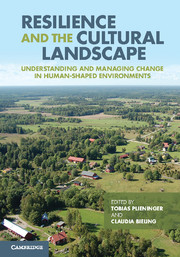 Resilience and the Cultural Landscape
Resilience and the Cultural Landscape Book contents
- Frontmatter
- Contents
- List of contributors
- Preface
- Part I Conceptualising landscapes as social–ecological systems
- Part II Analysing landscape resilience
- Part III Managing landscapes for resilience
- Part IV Perspectives for resilient landscapes
- 17 A heterarchy of knowledge: tools for the study of landscape histories and futures
- 18 Towards a deeper understanding of the social in resilience: the contributions of cultural landscapes
- 19 Resilience and cultural landscapes: opportunities, relevance and ways ahead
- Index
- References
19 - Resilience and cultural landscapes: opportunities, relevance and ways ahead
Published online by Cambridge University Press: 05 November 2012
- Frontmatter
- Contents
- List of contributors
- Preface
- Part I Conceptualising landscapes as social–ecological systems
- Part II Analysing landscape resilience
- Part III Managing landscapes for resilience
- Part IV Perspectives for resilient landscapes
- 17 A heterarchy of knowledge: tools for the study of landscape histories and futures
- 18 Towards a deeper understanding of the social in resilience: the contributions of cultural landscapes
- 19 Resilience and cultural landscapes: opportunities, relevance and ways ahead
- Index
- References
Summary
Introduction
Cultural landscapes have been shaped through interactions between people and nature; they are of outstanding importance for sustaining biodiversity and ecosystem services, and are currently under massive pressure from agricultural intensification, land abandonment and urbanisation (Jansen et al., 2009). The origins, dynamics and values of cultural landscapes were introduced at the beginning of this book by examining two distinct European landscapes (Chapter 1): the savanna-like dehesas in Spain and the low mountain range of the Black Forest in Germany. Although they differ considerably in their ecological, cultural, economic and political background and characteristics, these regions exhibit similar trajectories that point to many key issues of overall landscape change. This includes a long-lasting and complex human–nature interrelationship, which created a broad array of tangible as well as intangible values. Likewise, the current trends around the intensification–extensification and urbanisation–depopulation dichotomies can be traced in both landscapes, resulting in standardisation and thus a loss of landscape character. Both the dehesas and the Black Forest cases, however, highlighted that we frequently have a romanticised view of cultural landscapes and ignore the fact that many of them have been built on severe landscape interventions, unsustainable land use practices and social injustice. Moreover, these examples show that what we perceive as a typical and inherent character of a landscape may actually be more of a temporary snapshot than a long-term condition.
Addressing these critical issues in the study of landscapes and landscape change, the aim of this book is to develop an enhanced perspective that combines insights from the scientific communities dealing with the concepts of resilience and cultural landscapes. Applying this approach to the Black Forest and dehesa cases reveals insights as to how this approach may help to overcome the key shortcomings in conventional landscape studies.
- Type
- Chapter
- Information
- Resilience and the Cultural LandscapeUnderstanding and Managing Change in Human-Shaped Environments, pp. 328 - 342Publisher: Cambridge University PressPrint publication year: 2012


